It seems certain that Octavian (the future Emperor Augustus) created the the “Colonia Julia Hispellum” in ca. 42 BC, as part of the massive programme of settlement of the veterans of the civil wars. According to Paul Fontaine (referenced below, at p. 258-9), Porta Consolare was probably built in ca. 40 BC as a formal entrance to the originally unwalled city. He suggested (at p. 259) that the walls themselves belonged to a later phase, and that:
-
“An attractive hypothesis is that this second phase was executed at the time of Augustus’ restoration of Via Flaminia in 27 BC” (my translation).
These walls followed a roughly elliptical circuit of some 2 kilometres, with its longer axis in the NW-SE direction on the slope of Monte Subasio. They were built using small squared blocks formed from the limestone from this mountain, and were probably built for aesthetic rather than for defensive reasons. About half of the circuit, along the western side of the town, survives.
Four gates are identifiable in this section (starting from the south and proceeding clockwise):
-
✴Porta Consolare (which, as noted above, pre-dated the walls);
-
✴Porta Urbica;
-
✴Porta Venere; and
-
✴Porta dell' Arce.
Continuing the clockwise progression, traces of a fifth gate known as Arco di Augusto also survive.
Porta Consolare (ca. 42 BC)
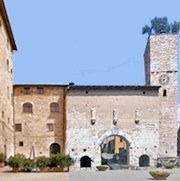
This gate provided the main access to the Roman city from the road that ran along the decumanus maximus of the centuriated veteran settlements to meet Via Flaminia at Mevania (Bevagna). A series of roads have been excavated at various layers nearby, dating from the pre-Roman to the medieval periods.
The Roman structure originally comprised two triple-arched gates with a cavaedium (rectangular courtyard open to the sky) between them. The medieval tower to the right and the house to the left are built on Roman foundations, which suggests that two defensive towers originally flanked the gate.
Little survives of the inner part of the structure, but the lower part of the outer gate is in good condition. It was built using blocks of local limestone set in rows laid without mortar and originally covered in marble.
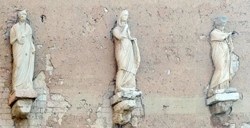
The upper part of the gate, which was probably originally in the form of an open loggia, was rebuilt in the 16th century. The three statues of figures in togas here came from a Roman sarcophagus (late 1st century BC) that was discovered near the Roman amphitheatre at this time. The gate derives its name from the fact that these figures were presumed to have been Consuls.
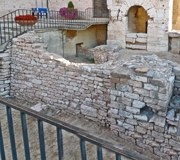
Porta Urbica
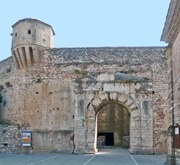
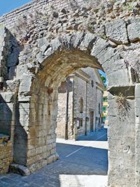

The inscription (ca. 1700) above the outer arch quotes from an elegy by Propertius.
The gate was closed for a long period, but re-opened in the 1960s.
If you pass through the gate and turn back to look along the wall to your right, you will see a phallic symbol in relief.
Porta Venere
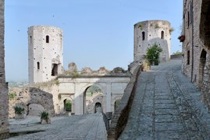
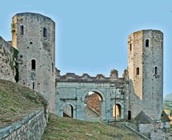
Inner view Outer view
Porta Venere probably articulated the road from the city to the Roman sanctuary below. It was given its name in ca. 1600, when the remains of a temple dedicated to Venus was discovered at Villa Fidelia.
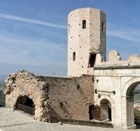
A number of buildings were erected over the gate over the centuries, and the side arches were closed. The present appearance is largely due to the restoration of the outer part of the gate in 1940-1, which was guided by the recovered remains on this site and by the model provided by Porta Consolare (above).
The two twelve-sided towers that flank the gate are probably of Roman origin, although they were rebuilt in the 12th century, using local pink and white limestone. They are known as Torri di Properzio, underlining that Spello (like Assisi and Bevagna) claims to be the birthplace of this Roman poet.
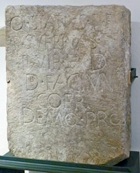
-
✴Quintus Statius, son of Publius; and
-
✴Publius Safena, son of Titus.
Porta dell' Arce (or Arco dei Cappuccini)
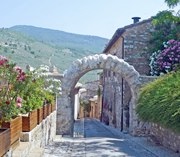
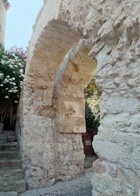
Arco di Augusto
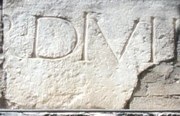
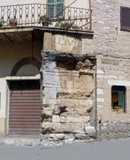
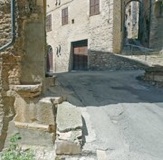
The gate takes its name from the inscription (CIL XI 5266) that was embedded here in the 18th century (on left above, and also visible under the balcony in the photograph in the middle), which referred to the Emperor Augustus (27 BC - 14 AD) as:
[Imp. Caesa]R DIVI F(ilius) [Augusto ?]
This inscription was found from the church of Santa Barbara probably related to the construction of the nearby aqueduct.
All that survives of this gate in the Roman walls is an impost (illustrated at the centre) and a single travertine block on the other side of the street (illustrated on the right), to the left of the Fonte del Mastro.
Read more:
P. Fontaine, “Cités et Enceintes de l'Ombrie Antique” (1990) Brussels
Return to Monuments of Spello.



